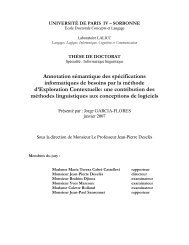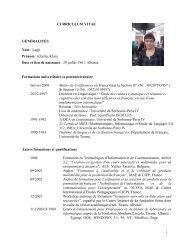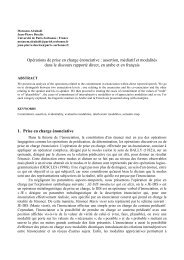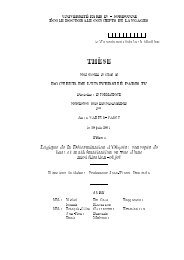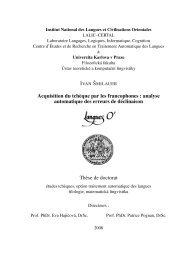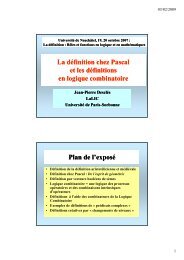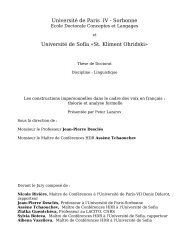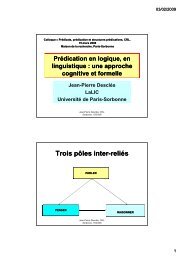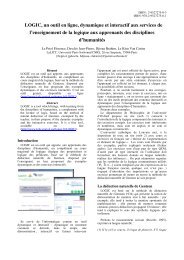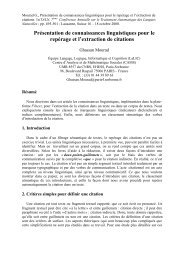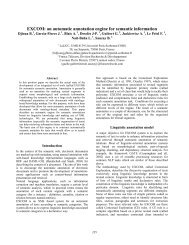- Page 1:
UNIVERSITÉ PARIS IV SORBONNE Écol
- Page 5 and 6:
Table des matières REMERCIEMENTS .
- Page 7 and 8:
CHAPITRE 5. ASPECTS FORMELS DE LA G
- Page 9 and 10:
8.3. CONCLUSION....................
- Page 11 and 12:
Introduction Les préverbes présen
- Page 13 and 14:
Introduction préposition dans chaq
- Page 15 and 16: Introduction Nous avons développé
- Page 17: Partie I. La problématique des pr
- Page 20 and 21: Chapitre 1 « Les prépositions et
- Page 22 and 23: Chapitre 1 la composition du mot) e
- Page 24 and 25: Chapitre 1 et particule réside dan
- Page 26 and 27: Chapitre 1 imperfectives (impf), cf
- Page 28 and 29: Chapitre 1 « 1) L’objet de dépa
- Page 30 and 31: Chapitre 1 des couples de connexion
- Page 32 and 33: Chapitre 1 Certains auteurs expliqu
- Page 34 and 35: Chapitre 1 iz- a une seule signific
- Page 36 and 37: Chapitre 1 Rousseau [1995a] consid
- Page 38 and 39: Chapitre 1 (I) parasynthèse imméd
- Page 40 and 41: Chapitre 1 Le phénomène de la tra
- Page 42 and 43: Chapitre 1 (17) *Az izpix kafe je I
- Page 44 and 45: Chapitre 1 1.3. Quelques analyses d
- Page 46 and 47: Chapitre 1 « Le préfixe iz- signi
- Page 48 and 49: Chapitre 1 pouvoir ensuite décider
- Page 50 and 51: Chapitre 1 2.2. SYSTÈME TEMPOREL 2
- Page 52 and 53: Chapitre 1 na, varhu nad za, sled,
- Page 54 and 55: Chapitre 1 1.3.4. Un exemple d’ap
- Page 56 and 57: Chapitre 1 (2) Un autre type est au
- Page 59: Partie II. Hypothèses et cadre th
- Page 62 and 63: Chapitre 2 responsable respectiveme
- Page 64 and 65: Chapitre 2 accepte que SpS soit du
- Page 68 and 69: Chapitre 2 Jackendoff s’oppose à
- Page 70 and 71: Chapitre 2 beaucoup plus complexe q
- Page 72 and 73: Chapitre 2 comparaison 11 , nous po
- Page 74 and 75: Chapitre 2 Commentaires et critique
- Page 76 and 77: Chapitre 2 expressions linguistique
- Page 78 and 79: Chapitre 2 « primitive », un type
- Page 80 and 81: Chapitre 2 pour étendre ensuite l
- Page 82 and 83: Chapitre 2 sont les prépositions v
- Page 84 and 85: Chapitre 2 avec les verbes de base
- Page 86 and 87: Chapitre 2 Le réseau de ot- (Figur
- Page 88 and 89: Chapitre 2 clairement dans l’anal
- Page 90 and 91: Chapitre 2 schéma across qui est c
- Page 92 and 93: Chapitre 2 deux ou à trois dimensi
- Page 94 and 95: Chapitre 2 transformation métaphor
- Page 96 and 97: Chapitre 2 Pour l’analyse de situ
- Page 98 and 99: Chapitre 2 X X X X X X X X X X X X
- Page 100 and 101: Chapitre 2 significations ou bien l
- Page 102 and 103: Chapitre 3 applicative (indépendan
- Page 104 and 105: Chapitre 3 Notre analyse des préve
- Page 106 and 107: Chapitre 3 3.3. Schèmes sémantico
- Page 108 and 109: Chapitre 3 y = garage x = voiture S
- Page 110 and 111: Chapitre 3 L’hypothèse fondament
- Page 112 and 113: Chapitre 3 Nous nous servirons souv
- Page 114 and 115: Chapitre 3 y = garage x = voiture S
- Page 116 and 117:
Chapitre 3 cognition : [Desclés 20
- Page 118 and 119:
Chapitre 3 passant par un langage u
- Page 120 and 121:
Chapitre 3 exemple ∃ = égologie
- Page 122 and 123:
Chapitre 3 traits 10 sans que ces t
- Page 124 and 125:
Chapitre 3 soutenons que chaque lan
- Page 126 and 127:
Chapitre 4 maison yéménite 2 où,
- Page 128 and 129:
Chapitre 4 EXT FRO EXT FRO x INT x
- Page 130 and 131:
Chapitre 4 Dans le domaine temporel
- Page 132 and 133:
Chapitre 4 La description des prép
- Page 134 and 135:
Chapitre 4 IN, EX, FR, FE, (B FE EX
- Page 136 and 137:
Chapitre 4 4.2.2. L’analyse des p
- Page 138 and 139:
Chapitre 4 Desclés relève des emp
- Page 140 and 141:
Chapitre 4 type de significations d
- Page 142 and 143:
Chapitre 4 3. Le contenu est inclus
- Page 144 and 145:
Chapitre 4 Ils retiennent de son an
- Page 146 and 147:
Chapitre 4 topologiques, elle perme
- Page 148 and 149:
Chapitre 5 l’application d’une
- Page 150 and 151:
Chapitre 5 Le combinateur S appliqu
- Page 152 and 153:
Chapitre 5 Applications de la logiq
- Page 154 and 155:
Chapitre 5 (a) et (b) ont la même
- Page 156 and 157:
Chapitre 5 simplification à droite
- Page 158 and 159:
Chapitre 5 Règle I : (x/y) y → x
- Page 160 and 161:
Chapitre 5 Les numérateurs contien
- Page 162 and 163:
Chapitre 5 un état résultatif con
- Page 164 and 165:
Chapitre 5 engendre des états rés
- Page 166 and 167:
Chapitre 5 Donc, les sept zones qui
- Page 168 and 169:
Chapitre 5 Ces définitions peuvent
- Page 170 and 171:
Chapitre 5 référentiel énonciati
- Page 172 and 173:
Chapitre 5 partant des configuratio
- Page 174 and 175:
Chapitre 5 entité, une focalisatio
- Page 176 and 177:
Chapitre 5 axe y: zones saillantes
- Page 178 and 179:
Chapitre 6 la bille et la boîte en
- Page 180 and 181:
Chapitre 6 Analyse A.1 : Le livre e
- Page 182 and 183:
Chapitre 6 Analyse B: En tant que c
- Page 184 and 185:
Chapitre 6 Avec P 1 = vole 1 ; P 2
- Page 186 and 187:
Chapitre 6 Les deux premiers types
- Page 188 and 189:
Chapitre 6 Définissons l’opérat
- Page 190 and 191:
Chapitre 6 8. EX conduit 2 les_soup
- Page 192 and 193:
Chapitre 6 outre- Les chiens passen
- Page 194 and 195:
Chapitre 6 En appliquant le quantif
- Page 196 and 197:
Chapitre 6 6.2.1.3. Développement
- Page 198 and 199:
Chapitre 6 l’action de l’agent.
- Page 200 and 201:
Chapitre 6 et leur réécriture en
- Page 202 and 203:
Chapitre 6 pervertir ← tourner ma
- Page 204 and 205:
Chapitre 6 Nous devons poser la loi
- Page 206 and 207:
Chapitre 6 Il est nécessaire donc
- Page 208 and 209:
Chapitre 6 (34a) (vers la_terre) va
- Page 210 and 211:
Chapitre 6 (39) Cette roche assèch
- Page 212 and 213:
Chapitre 6 11. B (3) B 2 (2) C B (B
- Page 214 and 215:
Chapitre 6 (51) Pierre s’est ense
- Page 216 and 217:
Chapitre 6 Préverbation à partir
- Page 219 and 220:
Chapitre 7. Analyse de la préposit
- Page 221 and 222:
Analyse de la préposition v et du
- Page 223 and 224:
Analyse de la préposition v et du
- Page 225 and 226:
Analyse de la préposition v et du
- Page 227 and 228:
Analyse de la préposition v et du
- Page 229 and 230:
Analyse de la préposition v et du
- Page 231 and 232:
Analyse de la préposition v et du
- Page 233 and 234:
Analyse de la préposition v et du
- Page 235 and 236:
Analyse de la préposition v et du
- Page 237 and 238:
Analyse de la préposition v et du
- Page 239 and 240:
Analyse de la préposition v et du
- Page 241 and 242:
Analyse de la préposition v et du
- Page 243 and 244:
Analyse de la préposition v et du
- Page 245 and 246:
Analyse de la préposition v et du
- Page 247 and 248:
Analyse de la préposition v et du
- Page 249 and 250:
Analyse de la préposition v et du
- Page 251 and 252:
Analyse de la préposition v et du
- Page 253 and 254:
Analyse de la préposition v et du
- Page 255:
Analyse de la préposition v et du
- Page 258 and 259:
Chapitre 8 le premier emploi spatia
- Page 260 and 261:
Chapitre 8 (3) No toj [Jurtalana] z
- Page 262 and 263:
Chapitre 8 kăm ‘vers’, do ‘j
- Page 264 and 265:
Chapitre 8 (10) Izlivam vodata iz
- Page 266 and 267:
Chapitre 8 Nous avons constaté que
- Page 268 and 269:
Chapitre 8 Il est possible de consi
- Page 270 and 271:
Chapitre 8 Le mouvement d’un endr
- Page 272 and 273:
Chapitre 8 EXT (LOC 1 ) forêt for
- Page 274 and 275:
Chapitre 8 si ce n’est plus aussi
- Page 276 and 277:
Chapitre 8 des montagnes bulgares (
- Page 278 and 279:
Chapitre 8 8.2. Le préfixe IZ- Le
- Page 280 and 281:
Chapitre 8 FRO INT (LOC) plantes MO
- Page 282 and 283:
Chapitre 8 (50) V rodilnoto otdelen
- Page 284 and 285:
Chapitre 8 (53) Dnes izčistix kă
- Page 286 and 287:
Chapitre 8 complètement. Il est ob
- Page 288 and 289:
Chapitre 8 axe y: activité activit
- Page 290 and 291:
Chapitre 8 s’abêtir’ dălăg (
- Page 292 and 293:
Chapitre 8 8.2.5. Invariant de IZ-
- Page 294 and 295:
Chapitre 8 contemporain (la ligne p
- Page 296 and 297:
Chapitre 9 ne pas nous aventurer da
- Page 298 and 299:
Chapitre 9 (11) « Les éditions Ha
- Page 300 and 301:
Chapitre 9 naturelle mais de ceux q
- Page 302 and 303:
Chapitre 9 contexte dans ces exempl
- Page 304 and 305:
Chapitre 9 loc1 (lieu non spécifi
- Page 306 and 307:
Chapitre 9 9.1.3. Domaine temporel
- Page 308 and 309:
Chapitre 9 Au contraire, le bulgare
- Page 310 and 311:
Chapitre 9 (45) Il s'assit dans un
- Page 312 and 313:
Chapitre 9 (60) C'est dans ses proj
- Page 314 and 315:
Chapitre 9 Approximation Ce type d
- Page 316 and 317:
Chapitre 9 Toutefois, selon le TLF,
- Page 318 and 319:
Chapitre 9 9.1.5. Invariant de DANS
- Page 320 and 321:
Chapitre 9 avons constaté que l’
- Page 322 and 323:
Chapitre 9 9.2.4. Invariant de HORS
- Page 324 and 325:
Chapitre 9 français soit par dans
- Page 326 and 327:
Chapitre 10 Entrée dans un espace
- Page 328 and 329:
Chapitre 10 disparition considérab
- Page 330 and 331:
Chapitre 10 L’évolution particul
- Page 332 and 333:
Chapitre 10 À cette représentatio
- Page 334 and 335:
Chapitre 10 spécialisation dans un
- Page 336 and 337:
Chapitre 10 enchaîner ‘mettre da
- Page 338 and 339:
Chapitre 10 Deuxième type de préf
- Page 340 and 341:
Chapitre 10 10.1.4. Acquisition d
- Page 342 and 343:
Chapitre 10 Invariant EN-: spécifi
- Page 344 and 345:
Chapitre 11 mouvement hors d'un lie
- Page 346 and 347:
Chapitre 11 qui est contraire au no
- Page 348 and 349:
Chapitre 11 axe y: lieu défini par
- Page 350 and 351:
Chapitre 11 11.1.2. Passage de l’
- Page 352 and 353:
Chapitre 11 épucer un chien équeu
- Page 354 and 355:
Chapitre 11 L’axe vertical du dia
- Page 356 and 357:
Chapitre 11 d’un changement qui v
- Page 358 and 359:
Chapitre 11 Invariant EX-: passage
- Page 361 and 362:
Conclusion Conclusion sur les résu
- Page 363 and 364:
Conclusion Concomitance (DANS) Appr
- Page 365 and 366:
Conclusion IZ IZ- EX- HORS DE Aller
- Page 367 and 368:
Conclusion bulgare avec v- et iz-.
- Page 369 and 370:
Synonymie apparente Conclusion Doma
- Page 371 and 372:
Conclusion prépositions de I. Tchi
- Page 373 and 374:
Conclusion un lieu - temporel dans
- Page 375 and 376:
Bibliographie [ACAD] ANDREJČIN, Lj
- Page 377 and 378:
Bibliographie DAYNOVSKA, Denitsa. 2
- Page 379 and 380:
Bibliographie DESCLÉS, Jean-Pierre
- Page 381 and 382:
Bibliographie GUENTCHÉVA, Zlatka.
- Page 383 and 384:
Bibliographie LE BOURDELLÈS, Huber
- Page 385 and 386:
Bibliographie ROMANOVA, Eugenia. 20
- Page 387 and 388:
Bibliographie VAGUER, Céline. 2007
- Page 389:
Annexe A. Abréviations utilisées



